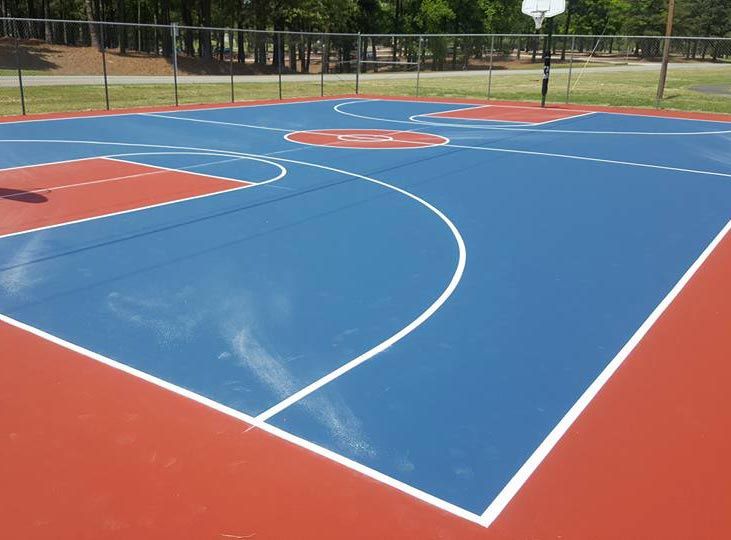
Understanding the Game: A Deep Dive into Basketball Court Lines
The Anatomy of the Basketball Court
Basketball court lines are designed with precision, each line serving a distinct purpose that impacts the game's flow and strategy. The dimensions of the court itself—94 feet in length and 50 feet in width at the professional level—create a stage for athleticism, strategy, and skill to unfold. The division of the court into two main sections by the midcourt line designates offensive and defensive zones, dictating team positioning and movement. The free-throw line, three-point arc, and the paint are critical areas that influence scoring, while the sidelines and baselines define the play area, setting the stage for boundary plays and spatial strategies.
Delving deeper, the design of a basketball court reflects the game's evolution. From the introduction of the three-point line to adjustments in the paint area, changes have been made to promote a faster-paced, more dynamic game. These modifications not only affect how the game is played but also how players train and develop their skills. A thorough understanding of the court's layout helps players make smarter decisions, whether it's taking a shot from beyond the arc or driving through the paint.

Free Throw Basketball Court Lines: The Mark of Precision
The free-throw line is a critical juncture in the game, representing a high-pressure moment where precision and calm are paramount. Situated 15 feet from the basket, this line offers players a chance to score unopposed, making free-throw proficiency a valuable skill. The psychological aspect of free-throw shooting cannot be overstated; players must maintain focus amid the intensity of the game and the distractions of opposing fans. Coaches often emphasize free-throw practice, recognizing its potential to change the game's outcome, especially in closely contested matches.
Furthermore, the free-throw line serves as a boundary for the key, influencing defensive strategies and rebound positioning. Players must navigate the rules regarding lane violations during free throws, adding another layer of tactical depth to this seemingly simple shot. Mastery of the free-throw line extends beyond individual skill, reflecting a team's discipline and strategic approach to exploiting every scoring opportunity.
Three-Point Arc: The Game Changer
The introduction of the three-point line has arguably been one of the most significant changes in basketball, altering the game's dynamics and strategies. It rewards long-range precision with an extra point, incentivizing players to develop their shooting range. This has led to a more open game, with players and teams leveraging the three-point shot to mount comebacks and stretch defenses. The line's varying distance across different levels of play—from high school to professional leagues—adds a layer of complexity to player development and game planning.
Strategically, the three-point line has been a catalyst for innovation in offensive tactics. Teams now frequently employ strategies that maximize spacing and create opportunities for shooters. This evolution reflects in player training, with a growing emphasis on shooting accuracy and range. The three-point shot's impact extends beyond the scoreboard, influencing player roles, scouting, and team composition, making it a central element in modern basketball's strategic landscape.
The Paint: A Battleground Under the Basket
Dominating the paint is crucial for both offensive and defensive success in basketball. This area, directly beneath the basket, is where physicality and skill collide, with players battling for rebounds, executing close-range shots, and defending the rim. Controlling the paint can lead to high-percentage scoring opportunities and is a key factor in a team's defensive efficacy. The ability to protect the basket and challenge opponents' shots without fouling is a hallmark of effective interior defense.
Offensively, players who excel in the paint often possess a combination of size, agility, and skill, able to outmaneuver defenders and finish strong at the rim. Meanwhile, defensive prowess in the paint requires anticipation, positioning, and the ability to contest shots without committing fouls. Teams that excel in controlling the paint often dictate the game's pace, leveraging their interior strength to create scoring opportunities and limit opponents' offensive options.
Sidelines and Baselines: Defining the Play Area
The sidelines and baselines are more than mere boundaries; they are integral to the strategic depth of basketball. They influence players' spatial awareness, dictate the flow of the game, and serve as crucial areas for inbound plays and strategic setups. Understanding how to effectively use the sidelines and baselines can provide teams with a tactical advantage, enabling them to exploit the full width and length of the court. Players must develop an acute awareness of their position relative to these lines to avoid turnovers and maximize their offensive and defensive strategies.
Inbound plays, particularly those near the opponent's basket, offer opportunities for quick scoring plays or to reset the offense. Teams often have specific plays designed for these situations, leveraging the unique positioning and rules governing inbound passes. The ability to execute under pressure, understanding the timing and spacing required, can turn these boundary lines into strategic assets. Coaches emphasize the importance of these plays, recognizing their potential to swing momentum and exploit defensive lapses.

Midcourt Basketball Court Line: The Division of Strategy
The midcourt line is not just a physical demarcation but a strategic one, influencing the transition between offense and defense. It plays a crucial role in shaping a team's approach to both aspects of the game. Offensively, crossing the midcourt line initiates the challenge of breaking down the defense, setting the stage for playmaking and scoring opportunities. Defensively, the midcourt line marks the point of contention, where teams apply pressure to disrupt their opponents' offensive flow and force turnovers.
The eight-second rule, requiring teams to advance the ball past the midcourt line within eight seconds, adds urgency to offensive strategies, emphasizing the importance of efficient ball handling and court awareness. This rule encourages teams to develop fast-break tactics and press defenses, creating a dynamic and fast-paced game. Understanding and exploiting the strategic implications of the midcourt line can enhance a team's ability to control the game's tempo and enforce their tactical will on opponents.
Table: Key Basketball Court Lines Measurements
|
Court Area |
Measurement (Feet) |
Description |
|
Free Throw Line |
15 from the basket |
Marks the spot for free throws. |
|
Three-Point Line |
Varies by level |
Distance from the basket varies by competition level. |
|
The Paint (Key) |
16 wide |
The area under the basket is crucial for scoring and defense. |
|
Sideline Length |
94 (NBA) / 84 (NCAA) |
Defines the length of the court. |
|
Baseline Width |
50 (NBA) / 50 (NCAA) |
Defines the width of the court. |
Equip Your Court with the Best: IE-Sports Basketball Goals
Incorporating high-quality basketball equipment into your training environment is essential for player development and game preparation. IE-Sports offers a range of basketball goals designed to meet the needs of players at all levels, from casual enthusiasts to professional athletes. Their products are engineered for durability, performance, and ease of use, ensuring that players have the best possible tools to hone their skills. Choosing the right basketball goal can make a significant difference in practice efficiency and player improvement, providing a professional-grade experience that simulates game conditions.
IE-Sports understands the importance of quality in basketball equipment. Their basketball goals are built to withstand the rigors of intense training and competitive play, offering features that cater to various playing styles and preferences. From adjustable heights for younger players to sturdy, weather-resistant materials for outdoor courts, IE-Sports has options to suit any setup. Investing in a top-tier basketball goal from IE-Sports is a step toward elevating your game, providing a foundation for skill development, strategic practice, and a deeper appreciation of basketball's nuances.
Conclusion: Mastering the Game from the Ground Up
The journey to basketball mastery begins with a fundamental understanding of the court and its markings. Each line on the court serves as a guide to the game's rules, strategies, and the infinite possibilities that unfold during play. By delving into the significance of these lines, players and enthusiasts can gain insights into the tactical essence of basketball, elevating their engagement with the sport. Coupled with high-quality equipment from IE-Sports, this knowledge forms a powerful foundation for growth, enjoyment, and success in basketball.
Mastering the game requires dedication, practice, and the right tools. IE-Sports' commitment to quality and performance in basketball goals mirrors the dedication players must bring to their development. Whether you're practicing free throws, perfecting your three-point shot, or strategizing plays, the right equipment can transform your training environment into a crucible of improvement. Embrace the journey of basketball mastery with the knowledge of court lines and the support of IE-Sports equipment, and experience the profound impact on your skills, strategy, and love for the game.
